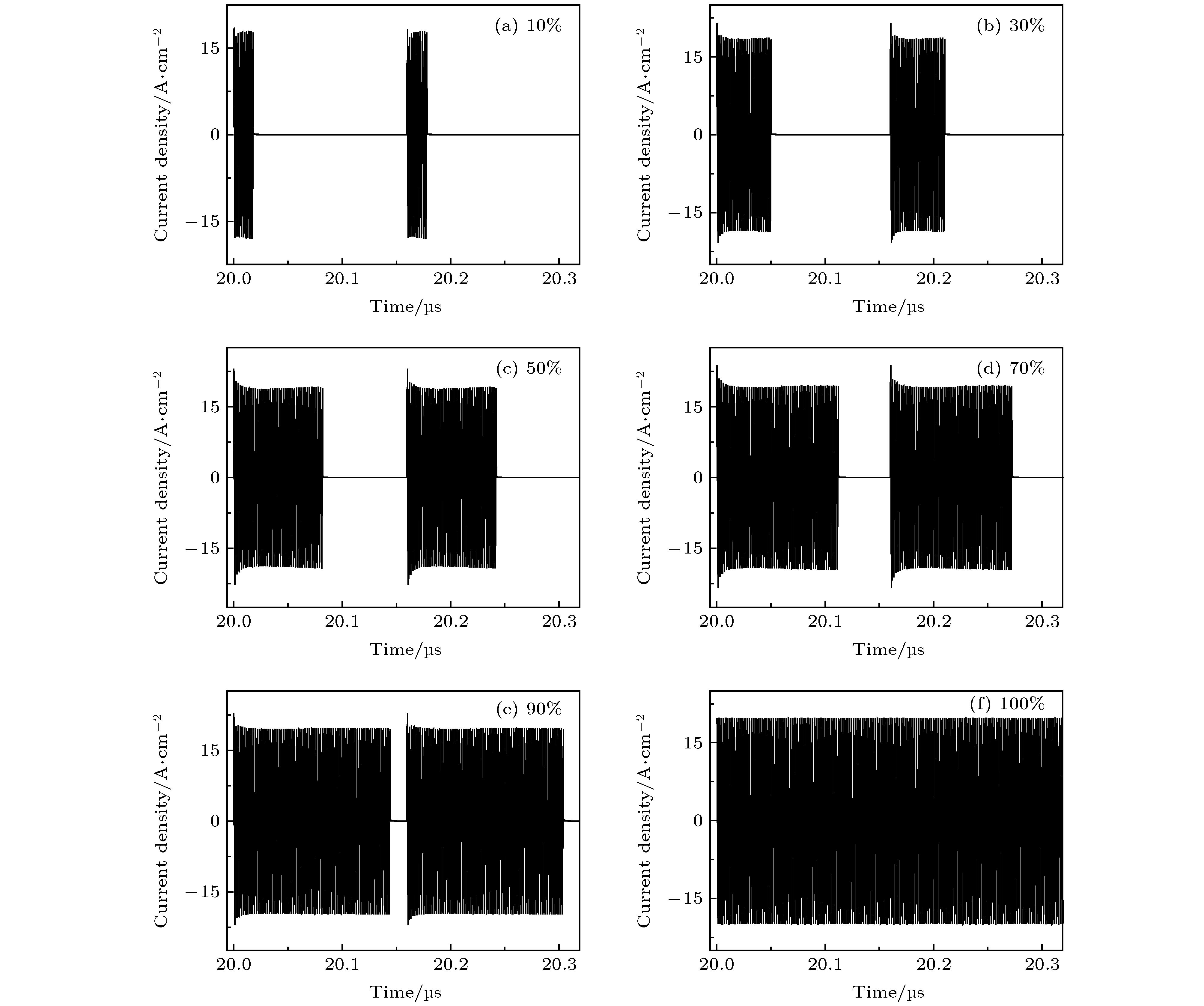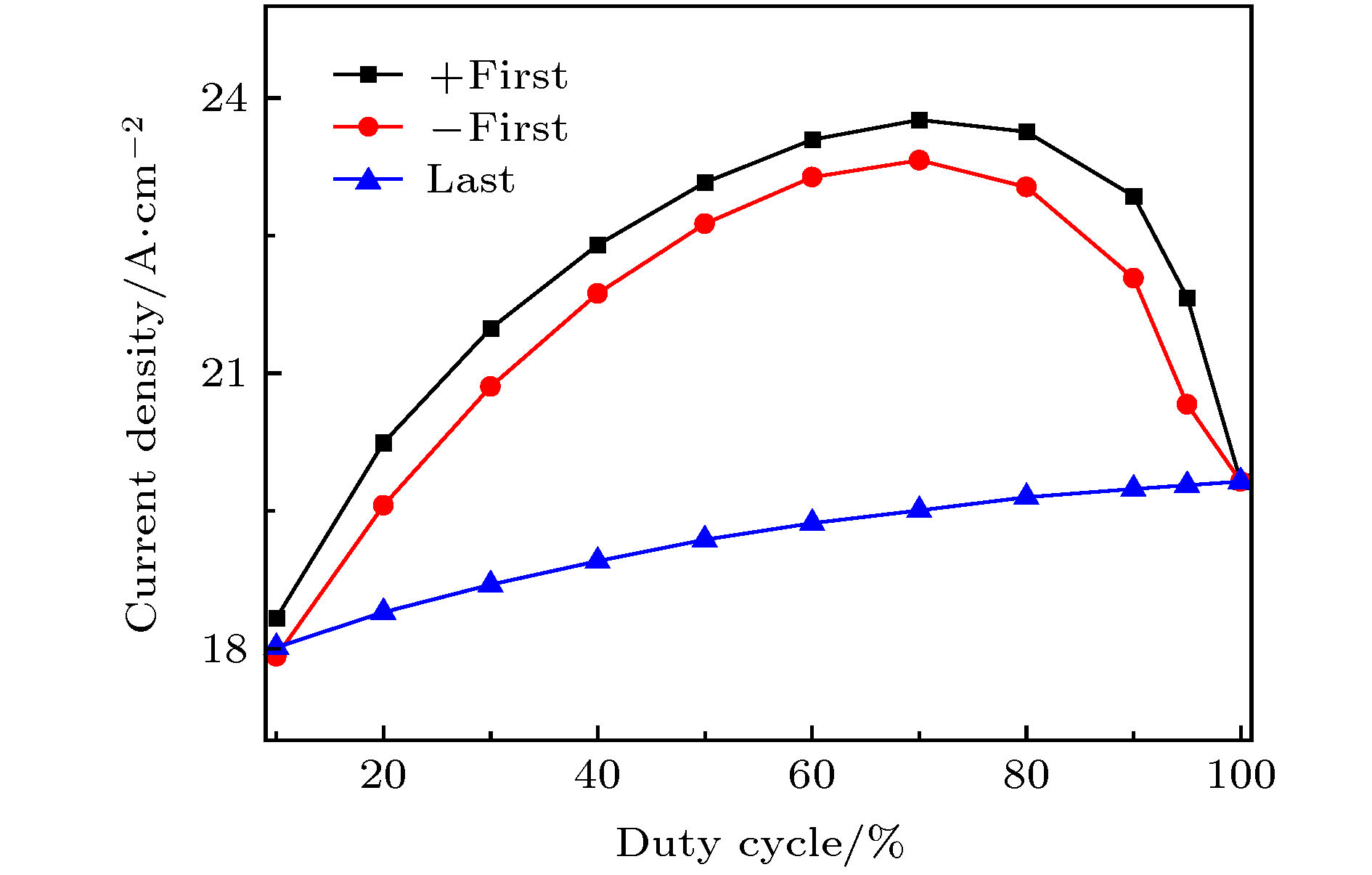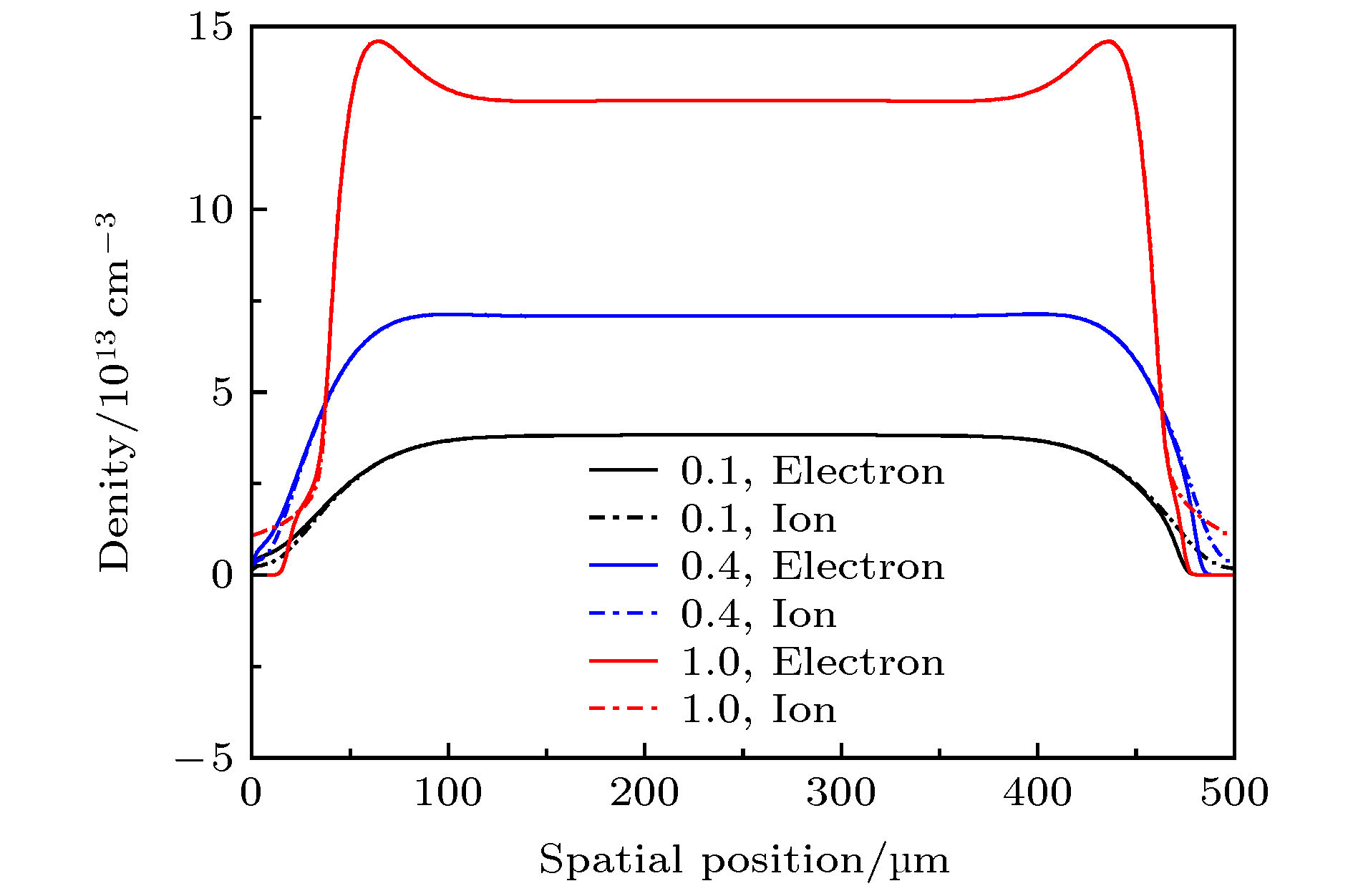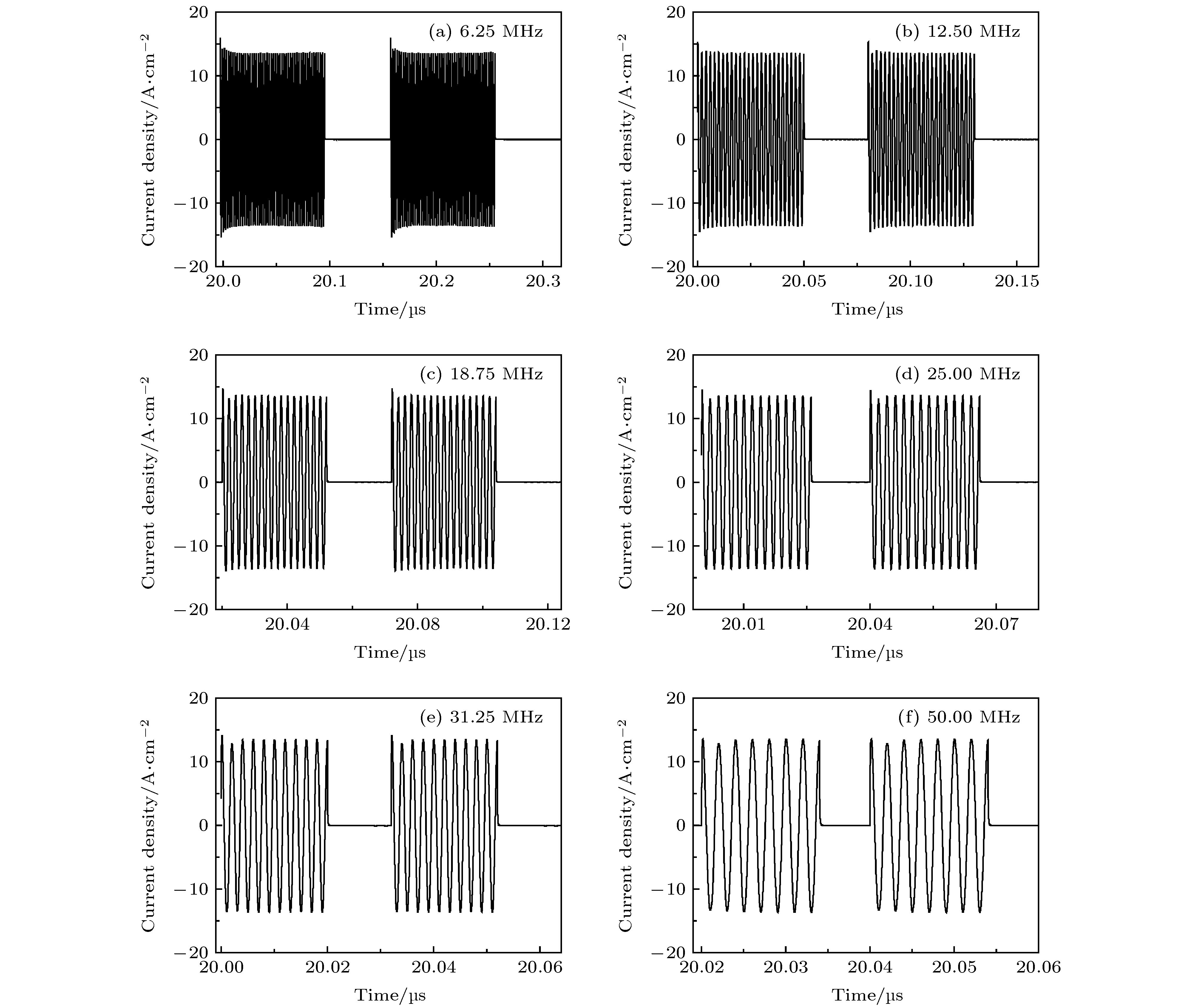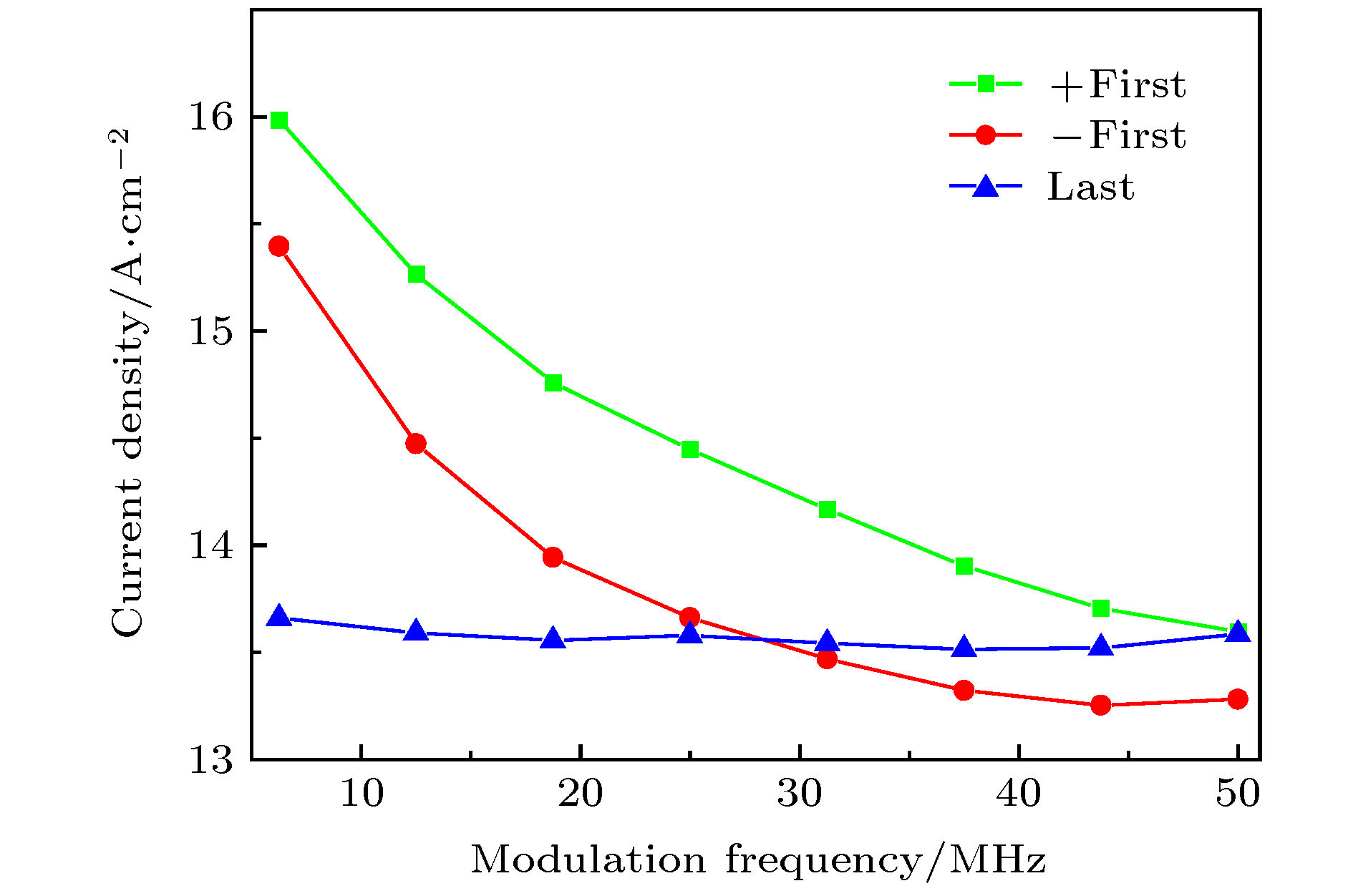-
大气压条件下, 引入脉冲调制是一种有效地提高射频放电稳定性的方法. 已有的研究表明, 当电源频率提高到甚高频乃至特高频频段的时候, 在脉冲调制条件下射频放电会表现出新的放电现象与放电规律. 本文借助于流体模型, 研究了当电源频率提高至500 MHz, 脉冲调制条件下介质阻挡放电的放电特性. 数值计算表明, 在电压开启的第一个周期内的正负半周期会各出现一次大电流放电的现象, 瞬时阳极鞘层的电场结构及介质表面电荷对该现象的产生具有重要影响; 并深入研究了占空比、调制频率与电压调制比对该大电流脉冲的影响, 以及大电流脉冲在放电从脉冲调制状态过渡到连续状态逐渐消失的过程. 本研究将对深入理解脉冲调制参数对介质阻挡放电的影响起到积极作用.Pulse-modulated discharge is an effective way to improve the stability of radio-frequency (rf) discharges. Previous studies have shown that with the power frequency increasing to the ultra-high frequency (UHF) band, the introduction of pulse modulation in rf discharges will bring about new discharge behaviors. In this paper, the fluid model is adopted to numerically investigate the new discharge characteristics in dielectric barrier discharges (DBDs) with the rf frequency larger than 500 MHz. A very large current peak occurs in the first positive and negative half cycle during the power-on phase, respectively. The spatial structure of electric field is given to further understand the underpinning physics of the large current peaks. Furthermore, the effects of duty cycle, modulation frequency and voltage modulation rates on the large current peaks are examined based on the computational data. This numerical study will deepen the understanding of DBDs modulated by pulses in the UHF band.
-
Keywords:
- atmospheric plasmas /
- dielectric barrier discharge /
- fluid model /
- pulse modulation /
- sheath structure
[1] Park J, Henins I, Herrmann H W, Selwyn G S 2001 J. Appl. Phys. 89 15
 Google Scholar
Google Scholar
[2] Iza F, Kim G J, Lee S M, Lee J K, Walsh J L, Zhang Y T, Kong M G 2008 Plasma Processes Polym. 5 322
 Google Scholar
Google Scholar
[3] Walsh J L, Zhang Y T, Iza F, Kong M G 2008 Appl. Phys. Lett. 93 221505
 Google Scholar
Google Scholar
[4] Zhang Y T, Li Q Q, Lou J, Li Q M 2010 Appl. Phys. Lett. 97 141504
 Google Scholar
Google Scholar
[5] Massines F, Rabehi A, Decomps P, Gadri R B, Ségur P, Mayoux C 1998 J. Appl. Phys. 83 2950
 Google Scholar
Google Scholar
[6] Lou J, Zhang Y T T 2013 IEEE Trans. Plasma Sci. 41 274
 Google Scholar
Google Scholar
[7] Balcon N, Hagelaar G J M, Boeuf J P 2008 IEEE Trans. Plasma Sci. 36 2782
 Google Scholar
Google Scholar
[8] Fridman G, Friedman G, Gutsol A, Shekhter A B, Vasilets V N, Fridman A 2008 Plasma Processes Polym. 5 503
 Google Scholar
Google Scholar
[9] Laroussi M 2005 Plasma Processes Polym. 2 391
 Google Scholar
Google Scholar
[10] Sousa J S, Niemi K, Cox L J, Algwari Q T, Gans T, O’connell D 2011 J. Appl. Phys. 109 123302
 Google Scholar
Google Scholar
[11] Waskoenig J, Niemi K, Knake N, Graham L M, Reuter S, Schulz-von der Gathen V, Gans T 2010 Plasma Sources Sci. Technol. 19 045018
 Google Scholar
Google Scholar
[12] Zhang Y T, Chi Y Y, He J 2014 Plasma Processes Polym. 11 639
 Google Scholar
Google Scholar
[13] Moravej M, Babayan S E, Nowling G R, Yang X, Hicks R F 2004 Plasma Sources Sci. Technol. 13 8
 Google Scholar
Google Scholar
[14] Boeuf J P, Pitchford L C 2005 J. Appl. Phys. 97 103307
 Google Scholar
Google Scholar
[15] Farouk T, Farouk B, Gutsol A, Fridman A 2008 Plasma Sources Sci. Technol. 17 035015
 Google Scholar
Google Scholar
[16] Zhang Y T, He J 2013 Phys. Plasmas 20 013502
 Google Scholar
Google Scholar
[17] Kwon H C, Jung S Y, Kim H Y, Won I H, Lee J K 2014 Phys. Plasmas 21 033511
 Google Scholar
Google Scholar
[18] He J, Hu J, Liu D W, Zhang Y T 2013 Plasma Sources Sci. Technol. 22 035008
 Google Scholar
Google Scholar
[19] Huang X, Sun L Q, Bao Y, Zhang J, Shi J J 2011 Phys. Plasmas 18 033503
 Google Scholar
Google Scholar
[20] Huo W G, Jian S J, Yao J, Ding Z F 2014 Phys. Plasmas 21 053505
 Google Scholar
Google Scholar
[21] Hu J T, Liu X Y, Liu J H, Xiong Z L, Liu D W, Lu X P, Iza F, Kong M G 2012 Phys. Plasmas 19 063505
 Google Scholar
Google Scholar
[22] Zhang Y T, Liu Y, Liu B 2017 Plasma Sci. Technol. 19 085402
 Google Scholar
Google Scholar
[23] Lee M U, Lee J K, Yun G S 2018 Plasma Processes Polym. 15 1700124
 Google Scholar
Google Scholar
[24] Wang G, Kuang Y, Zhang Y T 2020 Plasma Sci. Technol. 22 015404
[25] Liu X Y, Hu J T, Liu J H, Xiong Z L, Liu D W, Lu X P, Shi J J 2012 Appl. Phys. Lett. 101 043705
 Google Scholar
Google Scholar
[26] Leins M, Kopecki J, Gaiser S, Schulz A, Walker M, Schumacher U, Stroth U, Hirth T 2014 Contrib. Plasma Phys. 54 14
 Google Scholar
Google Scholar
[27] 王艳辉, 王德真 2003 物理学报 52 1694
 Google Scholar
Google Scholar
Wang Y H, Wang D Z 2003 Acta Phys. Sin. 52 1694
 Google Scholar
Google Scholar
[28] Zhang Y T, Wang D Z, Wang Y H 2005 Phys. Plasmas 12 103508
 Google Scholar
Google Scholar
[29] 徐学基, 诸定昌 1996 气体放电物理 (上海: 复旦大学出版社) 第277页
Xu X J, Zhu D C 1996 Discharge Physics of Gas (Shanghai: Fudan University Press) p277 (in Chinese)
[30] 张远涛, 王德真, 王艳辉 2005 物理学报 54 4808
 Google Scholar
Google Scholar
Zhang Y T, Wang D Z, Wang Y H 2005 Acta Phys. Sin. 54 4808
 Google Scholar
Google Scholar
[31] Lee D, Park J M, Hong S H, Kim Y 2005 IEEE Trans. Plasma Sci. 33 949
 Google Scholar
Google Scholar
[32] Zhang Y, Gu B A, Peng X W, Wang D Z, Wang W C 2008 Thin Solid Films 516 7547
 Google Scholar
Google Scholar
[33] Lee H W, Park G Y, Seo Y S, Im Y H, Shim S B, Lee H J 2011 J. Phys. D: Appl. Phys. 44 053001
 Google Scholar
Google Scholar
[34] Yuan X H, Raja L L 2003 IEEE Trans. Plasma Sci. 31 495
 Google Scholar
Google Scholar
[35] Zhang Y T, Wang D Z, Kong M G 2006 J. Appl. Phys. 100 063304
 Google Scholar
Google Scholar
-
-
[1] Park J, Henins I, Herrmann H W, Selwyn G S 2001 J. Appl. Phys. 89 15
 Google Scholar
Google Scholar
[2] Iza F, Kim G J, Lee S M, Lee J K, Walsh J L, Zhang Y T, Kong M G 2008 Plasma Processes Polym. 5 322
 Google Scholar
Google Scholar
[3] Walsh J L, Zhang Y T, Iza F, Kong M G 2008 Appl. Phys. Lett. 93 221505
 Google Scholar
Google Scholar
[4] Zhang Y T, Li Q Q, Lou J, Li Q M 2010 Appl. Phys. Lett. 97 141504
 Google Scholar
Google Scholar
[5] Massines F, Rabehi A, Decomps P, Gadri R B, Ségur P, Mayoux C 1998 J. Appl. Phys. 83 2950
 Google Scholar
Google Scholar
[6] Lou J, Zhang Y T T 2013 IEEE Trans. Plasma Sci. 41 274
 Google Scholar
Google Scholar
[7] Balcon N, Hagelaar G J M, Boeuf J P 2008 IEEE Trans. Plasma Sci. 36 2782
 Google Scholar
Google Scholar
[8] Fridman G, Friedman G, Gutsol A, Shekhter A B, Vasilets V N, Fridman A 2008 Plasma Processes Polym. 5 503
 Google Scholar
Google Scholar
[9] Laroussi M 2005 Plasma Processes Polym. 2 391
 Google Scholar
Google Scholar
[10] Sousa J S, Niemi K, Cox L J, Algwari Q T, Gans T, O’connell D 2011 J. Appl. Phys. 109 123302
 Google Scholar
Google Scholar
[11] Waskoenig J, Niemi K, Knake N, Graham L M, Reuter S, Schulz-von der Gathen V, Gans T 2010 Plasma Sources Sci. Technol. 19 045018
 Google Scholar
Google Scholar
[12] Zhang Y T, Chi Y Y, He J 2014 Plasma Processes Polym. 11 639
 Google Scholar
Google Scholar
[13] Moravej M, Babayan S E, Nowling G R, Yang X, Hicks R F 2004 Plasma Sources Sci. Technol. 13 8
 Google Scholar
Google Scholar
[14] Boeuf J P, Pitchford L C 2005 J. Appl. Phys. 97 103307
 Google Scholar
Google Scholar
[15] Farouk T, Farouk B, Gutsol A, Fridman A 2008 Plasma Sources Sci. Technol. 17 035015
 Google Scholar
Google Scholar
[16] Zhang Y T, He J 2013 Phys. Plasmas 20 013502
 Google Scholar
Google Scholar
[17] Kwon H C, Jung S Y, Kim H Y, Won I H, Lee J K 2014 Phys. Plasmas 21 033511
 Google Scholar
Google Scholar
[18] He J, Hu J, Liu D W, Zhang Y T 2013 Plasma Sources Sci. Technol. 22 035008
 Google Scholar
Google Scholar
[19] Huang X, Sun L Q, Bao Y, Zhang J, Shi J J 2011 Phys. Plasmas 18 033503
 Google Scholar
Google Scholar
[20] Huo W G, Jian S J, Yao J, Ding Z F 2014 Phys. Plasmas 21 053505
 Google Scholar
Google Scholar
[21] Hu J T, Liu X Y, Liu J H, Xiong Z L, Liu D W, Lu X P, Iza F, Kong M G 2012 Phys. Plasmas 19 063505
 Google Scholar
Google Scholar
[22] Zhang Y T, Liu Y, Liu B 2017 Plasma Sci. Technol. 19 085402
 Google Scholar
Google Scholar
[23] Lee M U, Lee J K, Yun G S 2018 Plasma Processes Polym. 15 1700124
 Google Scholar
Google Scholar
[24] Wang G, Kuang Y, Zhang Y T 2020 Plasma Sci. Technol. 22 015404
[25] Liu X Y, Hu J T, Liu J H, Xiong Z L, Liu D W, Lu X P, Shi J J 2012 Appl. Phys. Lett. 101 043705
 Google Scholar
Google Scholar
[26] Leins M, Kopecki J, Gaiser S, Schulz A, Walker M, Schumacher U, Stroth U, Hirth T 2014 Contrib. Plasma Phys. 54 14
 Google Scholar
Google Scholar
[27] 王艳辉, 王德真 2003 物理学报 52 1694
 Google Scholar
Google Scholar
Wang Y H, Wang D Z 2003 Acta Phys. Sin. 52 1694
 Google Scholar
Google Scholar
[28] Zhang Y T, Wang D Z, Wang Y H 2005 Phys. Plasmas 12 103508
 Google Scholar
Google Scholar
[29] 徐学基, 诸定昌 1996 气体放电物理 (上海: 复旦大学出版社) 第277页
Xu X J, Zhu D C 1996 Discharge Physics of Gas (Shanghai: Fudan University Press) p277 (in Chinese)
[30] 张远涛, 王德真, 王艳辉 2005 物理学报 54 4808
 Google Scholar
Google Scholar
Zhang Y T, Wang D Z, Wang Y H 2005 Acta Phys. Sin. 54 4808
 Google Scholar
Google Scholar
[31] Lee D, Park J M, Hong S H, Kim Y 2005 IEEE Trans. Plasma Sci. 33 949
 Google Scholar
Google Scholar
[32] Zhang Y, Gu B A, Peng X W, Wang D Z, Wang W C 2008 Thin Solid Films 516 7547
 Google Scholar
Google Scholar
[33] Lee H W, Park G Y, Seo Y S, Im Y H, Shim S B, Lee H J 2011 J. Phys. D: Appl. Phys. 44 053001
 Google Scholar
Google Scholar
[34] Yuan X H, Raja L L 2003 IEEE Trans. Plasma Sci. 31 495
 Google Scholar
Google Scholar
[35] Zhang Y T, Wang D Z, Kong M G 2006 J. Appl. Phys. 100 063304
 Google Scholar
Google Scholar
计量
- 文章访问数: 9158
- PDF下载量: 103
- 被引次数: 0













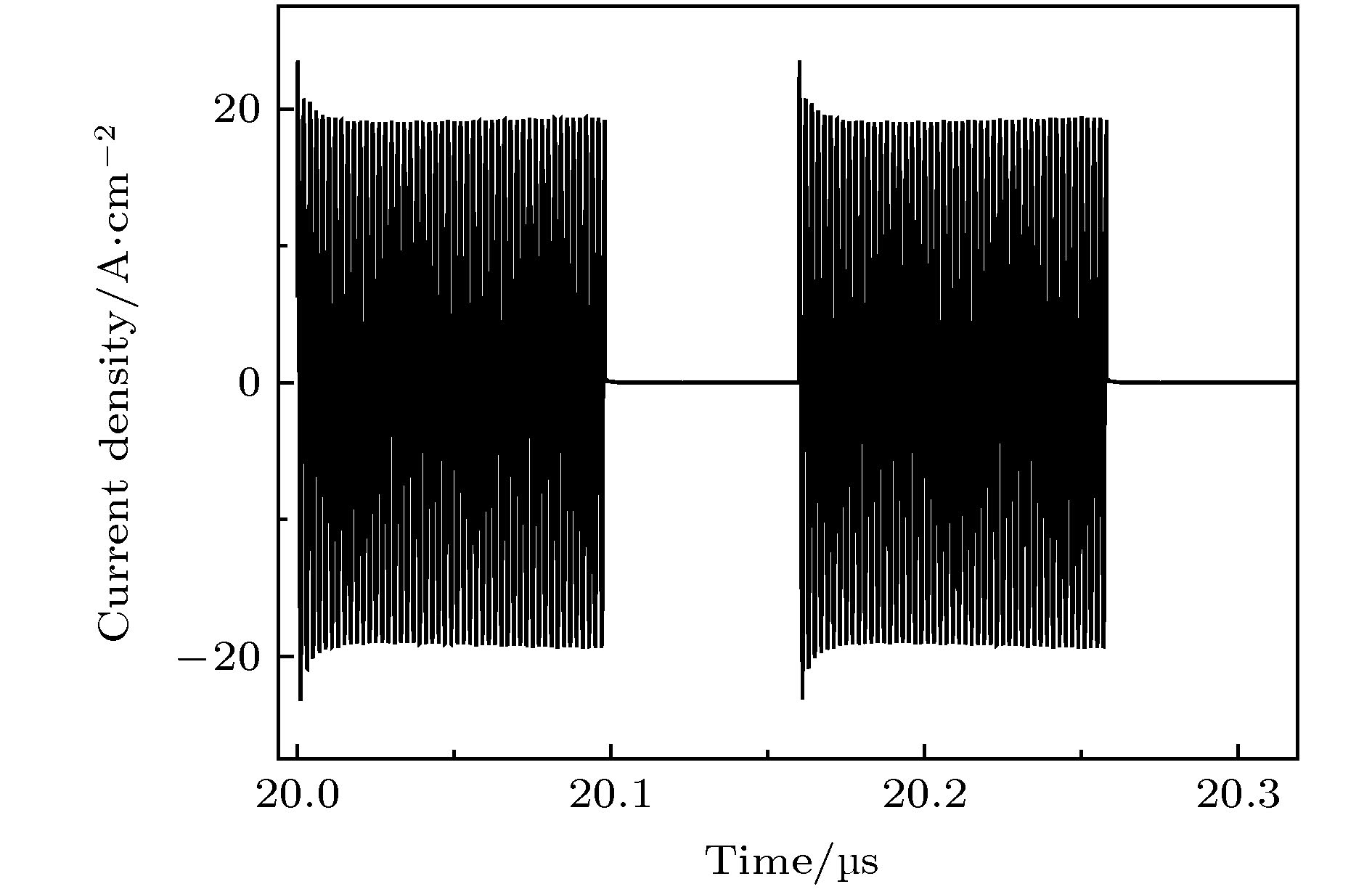
 下载:
下载:
